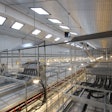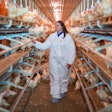A growing number of producers are switching at least part of their production to meet growing consumer demand. In Western Europe, non-cage egg production has reached 35%, while it comprises a more modest 4% of all U.S. production. That’s the view of Rick VanPuffelen, sales and marketing manager, Chore-Time Egg Production Systems, Milford, Ind., who spoke at the International Poultry Expo, last month in Atlanta, Ga., USA. But there’s a big difference between Western Europe and the United States, he said: In Europe, the drive to cage-free is due to legislation, while in the United States, it’s due to consumer choices.
VanPuffelen said that cage-free is part of the growth in the market for specialty eggs and egg products. The overall growth in the category was 63% from 2001 to 2005, with a 69.5% growth in eggs with nutritional claims, and an 85.3% growth in organic eggs.
VanPuffelen said that equipment and practices for cage-free seems a bit like “back to the future,” with photos from the 1950s looking similar to some cage-free operations today.
One fundamental change for a manager, he said, in a cage-free system, is to switch from being a system manager to becoming an animal manager. With a cage-free system, he said, animals must be trained to access feed and water; destructive animal behavior must be minimized; and the number of floor eggs must be kept to an absolute minimum.
There are six ways to house birds without cages, he said: deep litter floor houses; non-integrated aviary; integrated aviary; portal-style aviary; winter-garden; and free range. VanPuffelen said that in general, 1 to 1.5 square feet of floor space is required per bird; 1.1 for white birds, while 1.3 square feet for brown birds. He said that feeders can be either a circulating pan feeder of 30 to 40 birds per pan, or a trough feeder of 6 to 8 birds per foot. He recommends 10 feet of open space at each ends of the house. VanPuffelen also said that it’s critical to raise the pullets in the same type of system as they will later use to produce eggs. He added that pullets need to be trained to move up and around. Ways to do that are to stimulate three-dimensional movement; use winchable slats, perches, and drinks to train pullets to move up to nests; and train pullets to reduce the number of floor eggs.
Floor eggs are a primary problem of cage-free production, he said, but can be managed: 2% to 3% is generally considered acceptable, but 1% is quite doable. Ways to reduce floor eggs, VanPuffelen said, include collecting floor eggs five times per day, avoiding obstacles to nests, turning on nest lamps and open nests before normal house lighting, avoiding dark spots anywhere in the house, avoiding drafts in nests, and using training (electrical) lines around the perimeter and corners if necessary.
Other areas of concern, VanPuffelen said, are risk of various diseases with litter houses, red mites that are a big concern in the design and placement of equipment, cannibalism with bigger flocks, and some standards that require larger flocks to be separated within a house.













